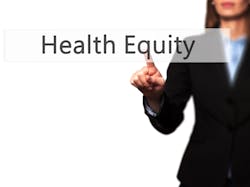For Vulnerable Populations, ‘COVID Is a Funhouse Mirror Amplifying Issues That Have Existed Forever’
COVID-19 is hitting some communities much harder than others. In Philadelphia, the neighborhoods with the highest rates of COVID-19 infections are predominantly black. Across the country, areas that have the highest rates of COVID-19 infection are also the areas that have the highest percentage of minority residents. Researchers who focus on vulnerable populations say this should come as no surprise and that the crisis is much bigger than COVID-19.
Shreya Kangovi, M.D., M.S.H.P., an associate professor of medicine at the Perelman School of Medicine at the University of Pennsylvania, is executive director of the Penn Center for Community Health Workers. Penn Medicine’s IMPaCT (Individualized Management for Patient-Centered Targets) program hires and trains trusted neighborhood residents to become community health workers, and the program has been scaled up across the country. During an April 10 virtual seminar put on by Penn’s Leonard Davis Institute of Health Economics, Kangovi joined two other researchers focused on vulnerable populations to talk about the impact of COVID-19.
Kangovi stressed the need to broaden the frame of this conversation. “This is not just about COVID. COVID is a funhouse mirror that is amplifying issues that have existed forever. People are not dying of COVID. They are dying of racism, of economic inequality and it is not going to stop with COVID,” she said.
There is a big public health fallout happening as people lose their livelihoods and as they become socially isolated and defer preventive care and healthy behaviors. “We need to not be surprised about this and not talk about it as a narrow COVID infectious response,” she added. “The positive feedback loops between poverty and pandemics is very well established. We need to talk about action. My work is about hiring those exact same individuals who are in disadvantaged circumstances or communities and who are natural helpers in those communities and putting them into healthcare systems and community-based organizations where they can effectively reach out and support individuals with a whole range of issues that may be affecting their health, the social determinants as well as medical determinants. We have established this model and it is nationally scaled and now we have pivoted it to this new world where a lot of the support is even more critical than ever. The real push right now is how we can reimburse these workers so that they are a part of the national response, not only to COVID but also to the wave of consequences.”
Kangovi was asked about weighing the tradeoffs between community health workers reaching out to people and the risk of spreading the virus and impacting their own health. “We have taken a pretty straightforward approach to balancing the tradeoffs,” she said. In some other countries, community health workers are being asked to function more like doctors, going door to door doing in-person contact tracing and providing clinical symptom management. “We simply do not feel that is appropriate,” she said. “There is not enough PPE, and the clinical guidelines are moving incredibly rapidly. This is much broader than COVID and will need to be addressed in a multi-faceted way. Our community health workers who are traditionally always in the streets, in homes and in their communities are currently safe in their homes. They are sheltering in place providing remote telephonic support, or via text or video chat. They are arranging for food delivery or helping people get unemployment benefits, or even organizing virtual dance parties. They are connecting people to crisis interventions and reinforcing COVID public health messaging. There is a lot for them to do while we are social distancing and, of course, beyond that.”
Digging Deeper and Asking Why
Gina South, M.D., M.S.H.P., is an assistant professor of emergency medicine at the Perelman School of Medicine. Her research focuses on how neighborhood context impacts health and safety in urban environments.
She stressed that the racial disparities we are seeing with COVID-19 mirror many of the racial disparities we see with other health outcomes such as maternal morbidity and mortality, cancer rates and death. “These COVID disparities aren’t really a surprise,” South said. In some Zip codes in West and South Philadelphia, which are predominantly black, up to 50 percent of adults have a diagnosis of hypertension. And although social distancing is a key way we can protect ourselves and our families from getting this disease, it is not easy for everyone. “When you think about black communities, you have a lot more multigenerational homes. It is much harder to separate kids who may be asymptomatic carriers from the elderly who are going to be at higher risk.”
Many essential workers who earn low wages are predominantly minorities. “Think about food services, environmental services, custodial staff, trash collectors, grocery clerks, bus drivers,” South said. “I saw an estimate that only one out of five black workers is able to stay home now. They are more likely to have to take public transportation. There is early evidence that living in neighborhoods with high levels of air pollution is associated with higher morbidity and mortality from COVID-19. Think about populations like the homeless. Blacks make up 40 percent of the homeless population in the country. Blacks and Latinos make up 56 percent of the U.S. prison population. People who are in prison, by definition, cannot socially distance themselves.
“We know all these things,” South said. “We need to dig deeper and ask why. Why is life expectancy so different at baseline? If you look at Society Hill, one of the richest neighborhoods in Philadelphia, it has an average life expectancy of 88. But if you go a few miles north to Strawberry Mansion, one of the poorest, you have a life expectancy of 68 years. That is a difference of 20 years within a few mile radius. Why are black communities more likely to be located in areas with higher air pollution? Why are low-wage workers we have deemed essential paid so little and why are they less likely to have health insurance and sick leave? Why are our neighborhoods so segregated? So we have to dig deeper and ask why, why, why. What you are going to arrive at is structural racism and structural economic inequality. These are some of the root causes of the disparities we are seeing with COVID and more broadly and those are the things that need to be addressed.”
Issues of Homelessness
Dennis P. Culhane, Ph.D., a professor of social policy in the School of Social Policy & Practice at Penn, discussed some of the unique challenges that homeless people face.
Even prior to the COVID crisis, there were a couple of crises emerging among the homeless that have occurred over the last 10 years, he noted. Most recently on the West Coast, there has been a 72 percent increase in unsheltered homeless people just since 2014. That has led to an explosion in the number of encampments. “These are parts of the country where the percentage of people unsheltered runs from 60 to 75 percent of the homeless population, compared to places like Philadelphia, where we generally run from 5 to 10 percent unsheltered depending on time of year,” Culhane said. “So that is one thing that has been creating underlying risk associated with unsanitary conditions and lack of access to basic resources in the encampments.”
Another factor is the aging of the homeless population. The homeless population is predominantly African-American men who never got access to the labor market in the 1980s, he said, and they are faced with “a lot of challenging circumstances that intersected with the crack cocaine crisis and the war on poor people, really, related to the drug markets and mass incarceration and addiction,” Culhane noted. “You have a whole brewing set of circumstances that displaced this generation for many years and they now have a life expectancy of 64. We see in the adult homeless population conditions that you would typically see in people 15 to 20 years later. So there is an accelerated aging process that effectively makes people homeless in their fifties elderly. They have these comorbid conditions that are such a significant risk for hospitalizations and acute care and death. There are a variety of health conditions that have accumulated across the life course and the inequality and racism that have accumulated across generations. All of that culminates in homelessness.”
What the Federal Government Could Do
Containing the pandemic requires accurate data, South said. “We can’t do anything without accurate data. That should be coordinated by the federal government, and also state and local government. I think we need to have focused task forces going to specifically address certain structural issues. For example, thinking about some of the issues with incarceration, we are seeing people released from jail early and a loosening of the contact that people on probation have to have with probation officers. Can we take lessons we are learning now to protect people and do some of those things afterwards?”
The speakers were asked what is the best thing the federal government could do right now that would make a difference for these communities six or 12 months down the road. “This pandemic won’t fade, because the pandemic isn’t COVIID. The pandemic is poverty,” Kangovi said. “The federal government, specifically CMS, needs to act to reimburse community health workers so that across the country millions of unemployed Americans can be put into this work force and be on the ground checking in on their neighbors and communities and addressing a range of economic, social, preventive health and COVID prevention needs right now.”
Culhane said the government should focus on income assistance. “The safety net for income is woefully deficient,” he said. One thing to work on is Supplemental Security Income (SSI) reform — making that program more accessible because we have aging and disabled people who are not getting into that program who have been squeezed out with layers and layers of obstacles that have been put in place over the years and cuts to the program. Culhane explained. “We need to make our disability program work."
Another area he mentioned is the unemployment insurance program. Only around 35 percent of unemployed people are eligible for unemployment insurance. “One of the things we have seen under the recent recovery funding is that we are going to push closer to 70 or 75 percent eligible. That is a great improvement. I hope the long-term impact is that the unemployment insurance program does widen its scope to include contract and part-time workers.”
The final thing Culhane mentioned is our tax credit program, which he said works very successfully to help poor families with children get $5,000 to $6,000 supplemental income each year to bring them up to the poverty level. “It is the most important anti-poverty program we have for non-elderly people, but single adults don’t get it. The maximum they can get is $500,” he explained. “Many people are homeless or on the fringes of housing, yet they are working. Forty-five percent of the homeless are working within a three-month period of their homelessness. They are not getting this tax credit. I think if we focus on these income insurance programs we have that are supposed to protect us from poverty, we could go a long way.”


